Input interpretation
![2-methyl-1-(3-sulfopropyl)naphtho[1, 2-d]thiazolium hydroxide](../image_source/61a91ee1a352d054f0385fcac68f97bd.png)
2-methyl-1-(3-sulfopropyl)naphtho[1, 2-d]thiazolium hydroxide
Basic properties
(=O)O)C2=C(C=CC3=CC=CC=C32)S1.[OH-] InChI identifier | InChI=1/C15H15NO3S2.H2O/c1-11-16(9-4-10-21(17, 18)19)15-13-6-3-2-5-12(13)7-8-14(15)20-11;/h2-3, 5-8H, 4, 9-10H2, 1H3;1H2/fC15H16NO3S2.HO/h17H;1h/q+1;-1 InChI key | AMSOMOMWDNIFKS-UHFFFAOYSA-N](../image_source/6b25ca670b8d5f982e9ff11d4980e1bf.png)
molar mass | 339.4 g/mol formula | C_15H_17NO_4S_2 empirical formula | O_4C_15S_2N_H_17 SMILES identifier | CC1=[N+](CCCS(=O)(=O)O)C2=C(C=CC3=CC=CC=C32)S1.[OH-] InChI identifier | InChI=1/C15H15NO3S2.H2O/c1-11-16(9-4-10-21(17, 18)19)15-13-6-3-2-5-12(13)7-8-14(15)20-11;/h2-3, 5-8H, 4, 9-10H2, 1H3;1H2/fC15H16NO3S2.HO/h17H;1h/q+1;-1 InChI key | AMSOMOMWDNIFKS-UHFFFAOYSA-N
Structure diagram
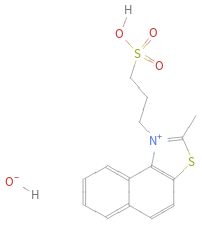
Structure diagram
Quantitative molecular descriptors
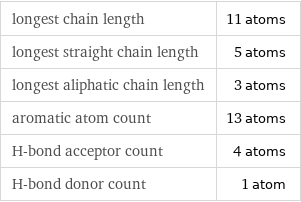
longest chain length | 11 atoms longest straight chain length | 5 atoms longest aliphatic chain length | 3 atoms aromatic atom count | 13 atoms H-bond acceptor count | 4 atoms H-bond donor count | 1 atom
Elemental composition
![Find the elemental composition for 2-methyl-1-(3-sulfopropyl)naphtho[1, 2-d]thiazolium hydroxide in terms of the atom and mass percents: atom percent = N_i/N_atoms × 100% mass percent = (N_im_i)/m × 100% Plan: • Write the chemical formula and gather atomic masses from the periodic table. • Determine values for N_i, m_i, N_atoms and m using these items. • Finally, compute the percents and check the results. Write the chemical formula: C_15H_17NO_4S_2 Use the chemical formula to count the number of atoms, N_i, for each element and find the total number of atoms, N_atoms, per molecule: | number of atoms O (oxygen) | 4 C (carbon) | 15 S (sulfur) | 2 N (nitrogen) | 1 H (hydrogen) | 17 N_atoms = 4 + 15 + 2 + 1 + 17 = 39 Divide each N_i by N_atoms to calculate atom fractions. Then use the property that atom fractions must sum to one to check the work: | number of atoms | atom fraction O (oxygen) | 4 | 4/39 C (carbon) | 15 | 15/39 S (sulfur) | 2 | 2/39 N (nitrogen) | 1 | 1/39 H (hydrogen) | 17 | 17/39 Check: 4/39 + 15/39 + 2/39 + 1/39 + 17/39 = 1 Compute atom percents using the atom fractions: | number of atoms | atom percent O (oxygen) | 4 | 4/39 × 100% = 10.3% C (carbon) | 15 | 15/39 × 100% = 38.5% S (sulfur) | 2 | 2/39 × 100% = 5.13% N (nitrogen) | 1 | 1/39 × 100% = 2.56% H (hydrogen) | 17 | 17/39 × 100% = 43.6% Look up the atomic mass, m_i, in unified atomic mass units, u, for each element in the periodic table: | number of atoms | atom percent | atomic mass/u O (oxygen) | 4 | 10.3% | 15.999 C (carbon) | 15 | 38.5% | 12.011 S (sulfur) | 2 | 5.13% | 32.06 N (nitrogen) | 1 | 2.56% | 14.007 H (hydrogen) | 17 | 43.6% | 1.008 Multiply N_i by m_i to compute the mass for each element. Then sum those values to compute the molecular mass, m: | number of atoms | atom percent | atomic mass/u | mass/u O (oxygen) | 4 | 10.3% | 15.999 | 4 × 15.999 = 63.996 C (carbon) | 15 | 38.5% | 12.011 | 15 × 12.011 = 180.165 S (sulfur) | 2 | 5.13% | 32.06 | 2 × 32.06 = 64.12 N (nitrogen) | 1 | 2.56% | 14.007 | 1 × 14.007 = 14.007 H (hydrogen) | 17 | 43.6% | 1.008 | 17 × 1.008 = 17.136 m = 63.996 u + 180.165 u + 64.12 u + 14.007 u + 17.136 u = 339.424 u Divide the mass for each element by m to calculate mass fractions. Then use the property that mass fractions must sum to one to check the work: | number of atoms | atom percent | mass fraction O (oxygen) | 4 | 10.3% | 63.996/339.424 C (carbon) | 15 | 38.5% | 180.165/339.424 S (sulfur) | 2 | 5.13% | 64.12/339.424 N (nitrogen) | 1 | 2.56% | 14.007/339.424 H (hydrogen) | 17 | 43.6% | 17.136/339.424 Check: 63.996/339.424 + 180.165/339.424 + 64.12/339.424 + 14.007/339.424 + 17.136/339.424 = 1 Compute mass percents using the mass fractions: Answer: | | | number of atoms | atom percent | mass percent O (oxygen) | 4 | 10.3% | 63.996/339.424 × 100% = 18.85% C (carbon) | 15 | 38.5% | 180.165/339.424 × 100% = 53.08% S (sulfur) | 2 | 5.13% | 64.12/339.424 × 100% = 18.89% N (nitrogen) | 1 | 2.56% | 14.007/339.424 × 100% = 4.127% H (hydrogen) | 17 | 43.6% | 17.136/339.424 × 100% = 5.049%](../image_source/06d88bcd5c62c6fd0cb350a88cb8e1b8.png)
Find the elemental composition for 2-methyl-1-(3-sulfopropyl)naphtho[1, 2-d]thiazolium hydroxide in terms of the atom and mass percents: atom percent = N_i/N_atoms × 100% mass percent = (N_im_i)/m × 100% Plan: • Write the chemical formula and gather atomic masses from the periodic table. • Determine values for N_i, m_i, N_atoms and m using these items. • Finally, compute the percents and check the results. Write the chemical formula: C_15H_17NO_4S_2 Use the chemical formula to count the number of atoms, N_i, for each element and find the total number of atoms, N_atoms, per molecule: | number of atoms O (oxygen) | 4 C (carbon) | 15 S (sulfur) | 2 N (nitrogen) | 1 H (hydrogen) | 17 N_atoms = 4 + 15 + 2 + 1 + 17 = 39 Divide each N_i by N_atoms to calculate atom fractions. Then use the property that atom fractions must sum to one to check the work: | number of atoms | atom fraction O (oxygen) | 4 | 4/39 C (carbon) | 15 | 15/39 S (sulfur) | 2 | 2/39 N (nitrogen) | 1 | 1/39 H (hydrogen) | 17 | 17/39 Check: 4/39 + 15/39 + 2/39 + 1/39 + 17/39 = 1 Compute atom percents using the atom fractions: | number of atoms | atom percent O (oxygen) | 4 | 4/39 × 100% = 10.3% C (carbon) | 15 | 15/39 × 100% = 38.5% S (sulfur) | 2 | 2/39 × 100% = 5.13% N (nitrogen) | 1 | 1/39 × 100% = 2.56% H (hydrogen) | 17 | 17/39 × 100% = 43.6% Look up the atomic mass, m_i, in unified atomic mass units, u, for each element in the periodic table: | number of atoms | atom percent | atomic mass/u O (oxygen) | 4 | 10.3% | 15.999 C (carbon) | 15 | 38.5% | 12.011 S (sulfur) | 2 | 5.13% | 32.06 N (nitrogen) | 1 | 2.56% | 14.007 H (hydrogen) | 17 | 43.6% | 1.008 Multiply N_i by m_i to compute the mass for each element. Then sum those values to compute the molecular mass, m: | number of atoms | atom percent | atomic mass/u | mass/u O (oxygen) | 4 | 10.3% | 15.999 | 4 × 15.999 = 63.996 C (carbon) | 15 | 38.5% | 12.011 | 15 × 12.011 = 180.165 S (sulfur) | 2 | 5.13% | 32.06 | 2 × 32.06 = 64.12 N (nitrogen) | 1 | 2.56% | 14.007 | 1 × 14.007 = 14.007 H (hydrogen) | 17 | 43.6% | 1.008 | 17 × 1.008 = 17.136 m = 63.996 u + 180.165 u + 64.12 u + 14.007 u + 17.136 u = 339.424 u Divide the mass for each element by m to calculate mass fractions. Then use the property that mass fractions must sum to one to check the work: | number of atoms | atom percent | mass fraction O (oxygen) | 4 | 10.3% | 63.996/339.424 C (carbon) | 15 | 38.5% | 180.165/339.424 S (sulfur) | 2 | 5.13% | 64.12/339.424 N (nitrogen) | 1 | 2.56% | 14.007/339.424 H (hydrogen) | 17 | 43.6% | 17.136/339.424 Check: 63.996/339.424 + 180.165/339.424 + 64.12/339.424 + 14.007/339.424 + 17.136/339.424 = 1 Compute mass percents using the mass fractions: Answer: | | | number of atoms | atom percent | mass percent O (oxygen) | 4 | 10.3% | 63.996/339.424 × 100% = 18.85% C (carbon) | 15 | 38.5% | 180.165/339.424 × 100% = 53.08% S (sulfur) | 2 | 5.13% | 64.12/339.424 × 100% = 18.89% N (nitrogen) | 1 | 2.56% | 14.007/339.424 × 100% = 4.127% H (hydrogen) | 17 | 43.6% | 17.136/339.424 × 100% = 5.049%
Elemental oxidation states
![The first step in finding the oxidation states (or oxidation numbers) in 2-methyl-1-(3-sulfopropyl)naphtho[1, 2-d]thiazolium hydroxide is to draw the structure diagram. Next set every oxidation number equal to the atom's formal charge: In 2-methyl-1-(3-sulfopropyl)naphtho[1, 2-d]thiazolium hydroxide hydrogen is not bonded to a metal with lower electronegativity, so it will have an oxidation state of +1. Any element bonded to hydrogen gains the bonding electrons, decreasing their oxidation state by 1 for every bond: With hydrogen out of the way, look at the remaining bonds. There are 3 carbon-nitrogen bonds, 3 carbon-sulfur bonds, 3 oxygen-sulfur bonds, and 14 carbon-carbon bonds. For each of these bonds, assign the bonding electrons to the most electronegative element. First examine the carbon-nitrogen bonds: element | electronegativity (Pauling scale) | C | 2.55 | N | 3.04 | | | Since nitrogen is more electronegative than carbon, the electrons in these bonds will go to nitrogen. Decrease the oxidation number for nitrogen in every highlighted bond (by 1 for single bonds, 2 for double bonds, and 3 for triple bonds), and increase the oxidation number for carbon accordingly: Next look at the carbon-sulfur bonds: element | electronegativity (Pauling scale) | C | 2.55 | S | 2.58 | | | Since sulfur is more electronegative than carbon, the electrons in these bonds will go to sulfur: Next look at the oxygen-sulfur bonds: element | electronegativity (Pauling scale) | O | 3.44 | S | 2.58 | | | Since oxygen is more electronegative than sulfur, the electrons in these bonds will go to oxygen: Next look at the carbon-carbon bonds: element | electronegativity (Pauling scale) | C | 2.55 | C | 2.55 | | | Since these elements are the same the bonding electrons are shared equally, and there is no change to the oxidation states: Now summarize the results: Answer: | | oxidation state | element | count -3 | C (carbon) | 1 | N (nitrogen) | 1 -2 | C (carbon) | 1 | O (oxygen) | 4 | S (sulfur) | 1 -1 | C (carbon) | 8 0 | C (carbon) | 2 +1 | C (carbon) | 2 | H (hydrogen) | 17 +3 | C (carbon) | 1 +4 | S (sulfur) | 1](../image_source/b131d1b46b1f06e83a3ed36ae07087b9.png)
The first step in finding the oxidation states (or oxidation numbers) in 2-methyl-1-(3-sulfopropyl)naphtho[1, 2-d]thiazolium hydroxide is to draw the structure diagram. Next set every oxidation number equal to the atom's formal charge: In 2-methyl-1-(3-sulfopropyl)naphtho[1, 2-d]thiazolium hydroxide hydrogen is not bonded to a metal with lower electronegativity, so it will have an oxidation state of +1. Any element bonded to hydrogen gains the bonding electrons, decreasing their oxidation state by 1 for every bond: With hydrogen out of the way, look at the remaining bonds. There are 3 carbon-nitrogen bonds, 3 carbon-sulfur bonds, 3 oxygen-sulfur bonds, and 14 carbon-carbon bonds. For each of these bonds, assign the bonding electrons to the most electronegative element. First examine the carbon-nitrogen bonds: element | electronegativity (Pauling scale) | C | 2.55 | N | 3.04 | | | Since nitrogen is more electronegative than carbon, the electrons in these bonds will go to nitrogen. Decrease the oxidation number for nitrogen in every highlighted bond (by 1 for single bonds, 2 for double bonds, and 3 for triple bonds), and increase the oxidation number for carbon accordingly: Next look at the carbon-sulfur bonds: element | electronegativity (Pauling scale) | C | 2.55 | S | 2.58 | | | Since sulfur is more electronegative than carbon, the electrons in these bonds will go to sulfur: Next look at the oxygen-sulfur bonds: element | electronegativity (Pauling scale) | O | 3.44 | S | 2.58 | | | Since oxygen is more electronegative than sulfur, the electrons in these bonds will go to oxygen: Next look at the carbon-carbon bonds: element | electronegativity (Pauling scale) | C | 2.55 | C | 2.55 | | | Since these elements are the same the bonding electrons are shared equally, and there is no change to the oxidation states: Now summarize the results: Answer: | | oxidation state | element | count -3 | C (carbon) | 1 | N (nitrogen) | 1 -2 | C (carbon) | 1 | O (oxygen) | 4 | S (sulfur) | 1 -1 | C (carbon) | 8 0 | C (carbon) | 2 +1 | C (carbon) | 2 | H (hydrogen) | 17 +3 | C (carbon) | 1 +4 | S (sulfur) | 1
Orbital hybridization
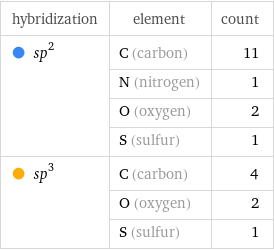
hybridization | element | count sp^2 | C (carbon) | 11 | N (nitrogen) | 1 | O (oxygen) | 2 | S (sulfur) | 1 sp^3 | C (carbon) | 4 | O (oxygen) | 2 | S (sulfur) | 1
Structure diagram
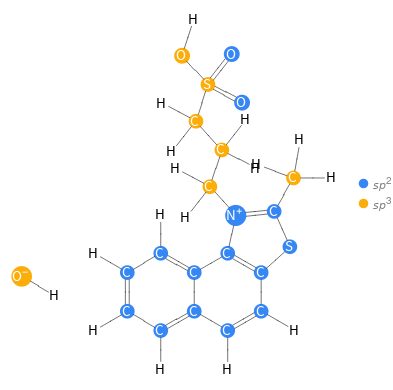
Orbital hybridization Structure diagram
Topological indices
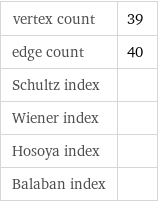
vertex count | 39 edge count | 40 Schultz index | Wiener index | Hosoya index | Balaban index |